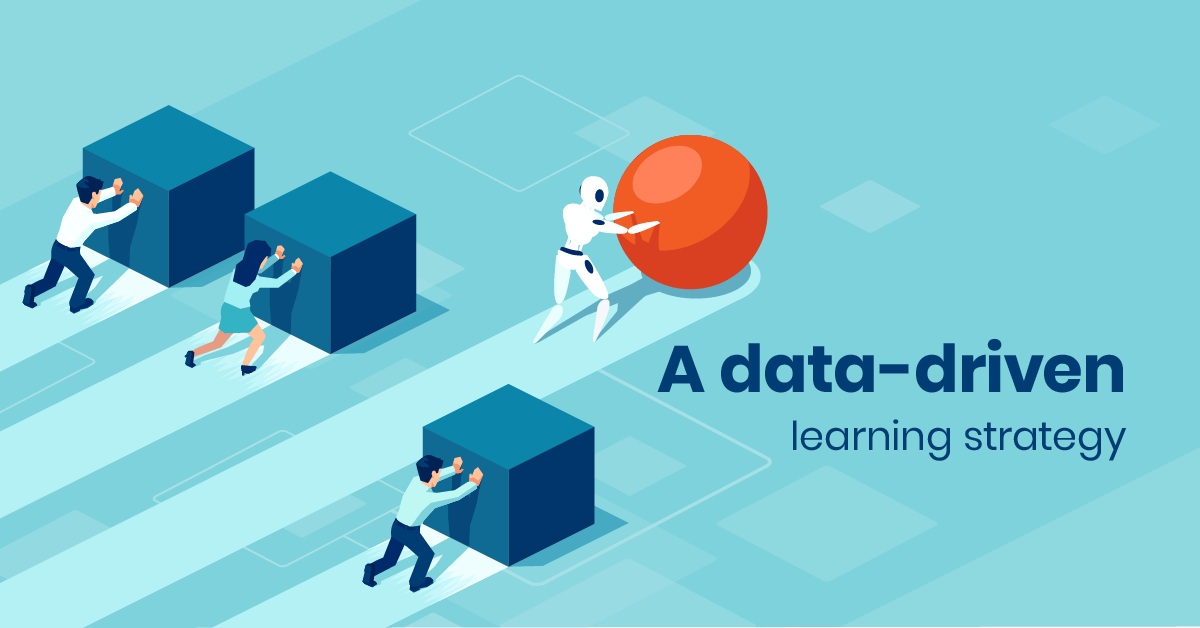You already know that employee training matters — but very often you need to prove exactly where you should invest, in what way, and how much. You need tangible training KPIs that will help you go from building a training program to developing your employees to reaching your business objectives.
And you need to do that in a way that doesn’t involve drowning yourself in superfluous data.
If you’re unsure how to measure training effectiveness, the solution is setting up specific, focused metrics. Metrics that will help you track learner progress, employee behavior, and performance in a seamless way.
In short, you need to find the right training KPIs to track through your LMS.
In this post, we’ll talk about the importance of applying a data-driven approach in learning, which training KPIs matter, and how to use them.
Why you should apply a data-driven approach in learning
Collecting data to measure training effectiveness is a money saver.
Consider this: according to a Gallup survey, a large company could save $60.3 million annually if its managers move their teams to the top quartile of engagement. And while the way to do that is through training, and the average large American business spent $17.7 million on training in 2019, most companies are not yielding anywhere near that ROI from their investment in training.
Why? Because in most cases, their training strategy is not data-driven.
Having a data-driven learning strategy means that your training system aligns with the changes you want to see in your bottom line — and vice versa. If, for instance, your goal is to increase the number of sales or customer satisfaction, then there are certain competencies and soft skills you need to feature in your training.
And you need to make sure to set training KPIs to measure these skills.
But while KPIs for training can (and should) differ from company to company based on your goals, there are still some training metrics that you need to know how to leverage.
We’ll explore these important training KPIs in this next section.

What training KPIs to track
When designing your data-driven learning strategy, you need to make sure you have an effective way to analyze learning objectives. Thankfully, if your LMS is worth its salt, it will be able to produce custom reports on any user, course, or activity without any extra work from you.
But you need a way to sort through and prioritize all this information.
A good idea would be to use Kirkpatrick’s training evaluation model which consists of four levels: reaction, learning, behavior, and results. Set up training KPIs for each one of these four levels. It will give you a good overview of whether your training succeeds in teaching employees the knowledge and skills it’s supposed to teach them.
And whether overall performance is improving because of training.
Level 1: Reaction KPIs
At this level, you want your training KPIs to measure how engaged learners are and how they interact with their training courses. For example, you want to learn whether they react better to specific types of content (e.g. gamified content). You also want to see how they respond to specific content delivery methods (e.g. pre-recorded videos vs live zoom seminars). This will give you some insights on how effective and engaging your current training setup is.
Some specific training KPIs to track at this level are:
- Attendance rate: This is particularly useful if parts of your training are optional or self-paced.
- Mobile app vs desktop use: Most good LMSs also have a mobile app your employees can download. At this point, you want to see if your employees prefer to learn from their phones or from their computers, as this will help you optimize the content accordingly.
- Employee feedback: Did they find the training engaging or boring? Helpful or confusing? Which parts would they change? The best way to get this data is through pulse surveys embedded in the training: that way employees can evaluate the course while it’s still fresh in their minds.
Level 2: Learning KPIs
At this level, you want to assess how much of the learning your employees have been able to digest. You can also see how much of this new knowledge employees can successfully apply in the workplace.
Some specific training KPIs to track at this level are:
- Training completion rate: This will allow you to see how many employees actually completed all the training. As this Training Industry article points out, it’s one of the most important training KPIs to track as it can also support compliance. For example, when it comes to the mandatory parts of your training, you should have a completion rate of one hundred percent.
- Average training completion time: Not only will this metric show you how much time it really takes employees to finish a course (versus how much time you think it takes), it’s also one of the training metrics that can help determine your ROI. For example, if you calculate the average completion time of a course and an employee’s average salary, you can get a sense of what your training really costs you.
- Pass/fail rates of course assessments: This will help you gauge employees’ learner progress and see whether you need to modify or simplify parts of the training.
- Average test scores: You can compare these scores against some standards or benchmarks to see how well your employees are performing and whether you have any knowledge gaps in your team.
- Information retention: You want to see how much of the knowledge your employees received has stayed with them long term. You can do that by making follow-up assessments part of your training. You can also get input from managers and team supervisors on how employees perform post-training and whether they’re making good use of the skills they learned.
Level 3: Behavior KPIs
At this level, you will be observing employee behavior pre- and post-training. You will also determine how confident they are in their new abilities while performing in the workplace.
Some specific training KPIs to track at this level are:
- Collaboration rate: People learn better when they learn together. Did your employees take advantage of all the collaboration opportunities you’re offering them throughout training? Did they work together to complete tasks and have conversations about learning? You can check this either by asking them directly through a pulse survey or by collecting data such as participation in discussion forums and comments.
- Learner confidence: How confident are your employees in their newfound knowledge and abilities? A pulse survey is one way to ascertain this but you should work in tandem with managers and supervisors on this one. The goal is to see whether there is a change in learner behavior and a confidence boost that could be attributed to training.
Level 4: Results KPIs
At this level, you need to look at your company holistically to determine whether and how much your data-driven learning strategy has increased the ROI. These are not KPIs you can track via your LMS (for the most part) but you should compare these findings with your findings in the other three levels to get the full picture.
Some things you need to measure at this level:
- Sales quota pre- and post-training: This should be measured in comparison to your overall goals and company strategy.
- Safety and compliance incidents: Ideally, you want to see the number of safety incidents reach zero or significantly decrease after training.
- Individual efficiency increase: Working in tandem with managers and supervisors, you need to ascertain how productive each employee is now, versus how productive they were before their training. This will allow you to identify people who do not incorporate the things they learned into their day-to-day work.
- Average efficiency increase: Once you have the individual scores, you can find how much more productive, on average, your employees have become after training.
- Overall growth rate: Of course, growth can come from other factors as well. But once you have all the other numbers (for example, the average efficiency increase) you’ll be able to see how much the training you offer has affected your growth rate.
How to use training KPIs to improve your learning strategy
Now that you know how to measure training effectiveness, you need to turn this exercise around. How can you use these training metrics to improve your learning strategy — and in return, your result KPIs?
Here are some actionable ways to use the training KPIs mentioned above:
Improve learner engagement
With the survey data from your “employee reaction” KPIs, you can discover which courses or training elements consistently score as boring, difficult, or confusing. Then, you can adjust and simplify those courses or add more gamification elements to make them more interactive.
Help personalize the learning experience
Use the data that shows you whether people prefer to learn from their phones or desktop. For instance, if a vast majority of the learners log in only from their phones, you should invest in more microlearning content and videos as it would be difficult to read large chunks of text on mobile. Likewise, if you find out that people enjoy quizzes or tests during a course, consider adding some of these elements to grab their attention.
Identify and address reasons for fail rates
If a training program has a higher fail rate than others, it could indicate that you need to provide additional resources and chances for catching up. Compare this data to the average completion time data. Do people score better when they take more time studying? Then perhaps you need to focus more on offering self-paced training.
Identify and rectify knowledge gaps
For example, if everyone is scoring higher in practical courses but lower in soft skills courses, it can be a sign you need to invest more in soft skills training.
All these fixes will make sure your data-driven learning strategy actually hits the spot and delivers the results you want to see.
Conclusion
Tracking the right training KPIs can be a game-changer when it comes to both identifying and increasing training effectiveness. But collecting and analyzing data manually is full-time work on its own, especially if you’re training large teams.
By using an LMS, you’ll get access to both automated and customized reports which will let you focus on what matters the most: improve training. That way, your employees will keep developing their skills and your company will keep hitting its objectives.



